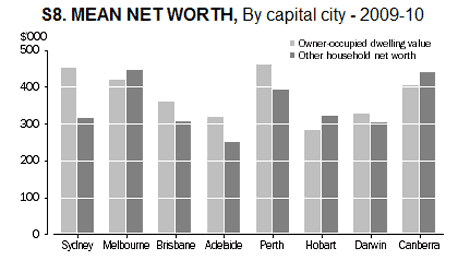Rich getting richer, poor getting moderately left behind: ABS
The wealthiest 20% of households have increased their average net worth 15% since 2005-06, while the poorest 20% of households saw only a 4% rise, according to the Australian Bureau of Statistics.
The wealthy households had an average net worth of $2.2 million per household, and accounted for around two-thirds of total household wealth.
The poorest 20% of households had an average net worth of $32,000 per household, which accounted for 1% of total household wealth.
The average wealth of an Australian household in 2009-10 was $720,000, up 14% since 2005-06, with one in five households owning property other than their own home, including holiday homes and rental properties.

Source: Australian Bureau of Statistics
The research concluded there was a strong correlation between net worth and home ownership, and for many households, their dwelling is their main asset.
Owners without a mortgage had the highest mean net worth of $1,179,000 which is 64% higher than the mean net worth of all households, at $720,000.
Renters had lower mean net worth of $158,000 – constituting 22% of the average for all households. Private renters averaged net worth of $176,000, while renters from state/territory housing authorities averaged net worth of $42,000.
The survey found wealth was distributed between households somewhat differently to income.
While the 20% of households comprising the lowest net worth quintile accounted for only 1% of total household net worth, they accounted for 12% of total gross household income.
The 20% of households comprising the lowest gross household income quintile accounted for 4% of total gross household income but 13% of total net worth.
The ABS concludes the differences in the distribution of wealth and income partly reflects the common pattern of wealth being accumulated during a person's working life and then being used during retirement.
Many households with relatively low wealth have relatively high income, especially if they are younger households, and conversely older households may have accumulated relatively high net worth over their lifetimes, but have relatively low income in their retirement.
In addition, some households have low or even negative incomes due to business or investment losses, but still have relatively high levels of net worth.
The ABS found differences in the average levels of wealth between the states and territories, with Queensland, South Australia and Tasmania below the national average.
Household wealth was more concentrated in metropolitan areas. The average net worth of households located in capital cities was $772,000 as compared with $629,000 in areas outside of capital cities.
Owner-occupied homes were the main asset held by Australians. Mortgages on them were the main liability, with over two-thirds of Australian households owning their own home either outright or with a mortgage.
For households that owned their home outright (2.7 million households), the average value of the home was $541,000. For those households with a mortgage on their home, the average value of the home was $521,000, and the average mortgage outstanding was $188,000, giving a net home equity of $333,000. The average value of household contents was $61,000. The principal outstanding on vehicle loans averaged $2,300 per household, and the average household credit card debt was $2,600.
Superannuation was the main financial asset held by households, with three-quarters of all households having some superannuation assets.
For households with superannuation, the average value of their superannuation was $154,000, but for half of these, the value was less than $60,000.
The group with the highest mean household net worth was couple only aged 55 to 64 ($1,317,000) with many either nearing the end of their time in the labour force or have recently retired, that is, they are at the end of the main wealth accumulation period.
People over 65 had lower net worth on average ($1,111,000 for couples and $572,000 for lone persons), at least partly reflecting a run-down of assets to support consumption in retirement.
The ABS notes these older cohorts may also have had less opportunity for capital accumulation in earlier decades, for example, because women had lower participation rates in the paid work force.
Single people aged under 35 had the lowest mean household net worth, at $151,000. The mean household net worth of couple only households with a reference person aged under 35 was $237,000 or $119,000 per person.
One-parent households with dependent children had a mean net worth of $276,000, compared with $827,000 for couple family households with dependent children.
Home ownership for the one-parent family households was about half that of the couple family households – 40% and 77% respectively.